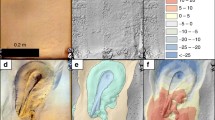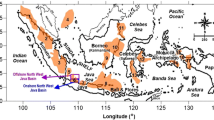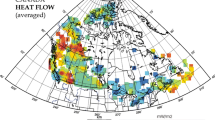Abstract
The temperature increases downwards in the crust and there is therefore a transport of heat upwards, referred to as the heat flow. Most of the flow is by conduction (thermal diffusion). Flow of porewater will also transport heat in the subsurface but the flow rates in sedimentary basins are normally so small that we can ignore the contribution from fluid flow. Around igneous intrusions there is usually thermal convection with high flow rates and heat transport. In shallow areas with high flow rates of meteoric water, advective heat transport is also significant.
Access provided by Autonomous University of Puebla. Download chapter PDF
Similar content being viewed by others
Keywords
These keywords were added by machine and not by the authors. This process is experimental and the keywords may be updated as the learning algorithm improves.
The temperature increases downwards in the crust and there is therefore a transport of heat upwards, referred to as the heat flow. Most of the flow is by conduction (thermal diffusion). Flow of porewater will also transport heat in the subsurface but the flow rates in sedimentary basins are normally so small that we can ignore the contribution from fluid flow. Around igneous intrusions there is usually thermal convection with high flow rates and heat transport. In shallow areas with high flow rates of meteoric water, advective heat transport is also significant.
The source of the heat is mainly radioactive processes which are particularly important in the continental crust due to the enrichment of uranium, thorium and potassium in granitic rocks.
Heat is transported through sedimentary basins mostly by conduction following the heat flow equation:
The thermal conductivity (c) is expressed as \({\rm{Wm}}^{ - 1}{^\circ} {\rm{C}}^{ - 1}\) or \({\rm{Wm}}^{ - 1}{^\circ} {\rm{K}}^{ - 1}\) which is the heat (W) transported over a given distance (m) with a certain drop in temperature (°C). Temperature is expressed as Celsius (°C) or Kelvin (K) but Fahrenheit was and still is commonly used in the USA. Conductivity may also be expressed in terms of calories (cal), which is an alternative unit for energy/heat. 1 W equals 1 J/s or 0.239 cal/s.
The heat flow (Q) is most commonly expressed by W/m2 but can also be expressed as cal/cm2s or joule/cm2s. A heat flow of 70 mW/m2 corresponds to 1.4 μcal/cm2s. This is the heat flow unit (mW/m2) which may be referred to as HFU. The temperature of a volume of rock is a function of the heat flux and the conductivity of rocks and fluids. The increase in temperature with depth (temperature gradient) is called the geothermal gradient (dT/dz). Typical geothermal gradients may also be written as ∇T and in sedimentary basins are usually 25–45°C/km.
In a sedimentary basin there is the background heat flux from the underlying basement, and granitic rocks have higher heat production and temperatures than basic rocks. The sedimentary sequences overlying the basement also produce heat by radioactive reaction and black shales with a high content of organic matter often have a relatively high uranium content. This additional heat source may be significant in terms of increasing the heat flux and the geothermal gradients in sedimentary basins.
The temperature distribution (geothermal gradients) in sedimentary basins can vary regionally and over geologic time. This determines both the generation and expulsion of petroleum, and it also strongly influences the reservoir quality. It is therefore important to understand the processes that control heat transport in sedimentary basins.
In rocks with low conductivity (like mudstones and shales) the geothermal gradients will be high and in highly conductive rocks (like salt) the geothermal gradients will be low (Fig. 9.1). The thermal conductivity of salt (halite and anydrite) is \(5.5\ {\rm{Wm}}^{ - 1}{^\circ} {\rm{C}}^{ - 1}\), while shales may have conductivities between 1.0 and \(2.5\ {\rm{Wm}}^{ - 1}{^\circ} {\rm{C}}^{ - 1} \). Sandstones and limestones have values between shales and salt.
In a situation where a rock is filled with stationary porewater the total heat flux (Q) is the sum of the heat conducted through both the rock’s matrix and pores (porosity φ filled with fluids):
C r is the conductivity of the solid rock and C f is the conductivity of the fluids (usually water) in the pore space. Water (fresh) at 20°C has a conductivity of 0.6 W/mK while seawater and saline brines are much more conductive. The conductivity of common sedimentary minerals ranges from \(7.7\ {\rm{Wm}}^{ - 1}{^\circ} {\rm{C}}^{ - 1}\) for quartz to 1.8 for illite and smectite. The conductivity is therefore to a large extent a function of the quartz content and the water content (porosity).
The conductivity of shales from the North Sea ranges from about 0.8 to \(1.1\ {\rm{Wm}}^{ - 1}{^\circ} {\rm{C}}^{ - 1}\) (Midttømme et al. 1997) so they are not very much more conductive than water. The conductivity parallel to bedding may be up to 70% higher than perpendicular to bedding.
Most of the heat transport is vertical except around hydrothermal or igneous intrusions, but in the case of steeply dipping beds the conductivity would be higher.
Over a limited vertical interval of the sedimentary section the heat flow may be relatively constant and we see from Eq. (9.2) that the geothermal gradient is inversely related to the conductivity.
When there are rocks with low conductivity near the surface the geothermal gradient will be higher so that the underlying sediments will be warmer. This is called a blanketing effect. Mudstones with low thermal conductivity on top of granites or older sedimentary rocks will have this effect.
Salt with high conductivity has the opposite effect. Because the temperature gradient through salt is low, the temperature will be relatively high at the top of the salt and low at the bottom. This has consequences for maturation of source rocks. This is a very important effect for petroleum prospects below thick salt layers, i.e. in the Gulf of Mexico, offshore Brazil, West Africa and the North Sea. The temperatures below the salt will be significantly lower than normal at this depth. This means that the reservoir quality of sandstones reservoirs will be better due to less quartz cement. Lower temperatures will also preserve more petroleum as oil or condensate as there will be less cracking to gas.
The heat flux is only constant in an equilibrium situation. When sediments subside they are heated and a part of the background heat flux is used to heat the subsiding rocks (Fig. 9.2). This is equal to the heat capacity of the rocks and the subsidence rate. In basins with high sedimentation rates the heat flow is strongly reduced and in the Plio-Pleistocene depocentres the geothermal gradients are down to 20–25°C/km (Harrison and Summa 1991).
Geothermal gradients as a function of rapid uplift (erosion) or subsidence (sedimentation). During subsidence some of the heat flow is used to heat the subsiding sediments and underlying basement and this will reduce the geothermal gradients, forming cold basins. During uplift the heat from cooling rocks will add to the heat flux, producing steeper geothermal gradients
During subsidence and sedimentation the sediments must be heated, and this heat is taken from the background heat flow and the geothermal gradient is reduced.
During subsidence the heat flux is:
The heat capacity of rock including porewater is \(\left( {C_{{\rm(hc)}} } \right)\).
Here Q b is the background heat flux from the basement, F s is the subsidence rate (downward flux of rocks) and C hc is the heat capacity of the rocks. When rocks are uplifted and cooled the heat given off from the cooling rocks adds to the background heat flow:
During uplift the heat flux becomes:
Here F ur is the rate of uplift. The heat capacity of the mineral matrix may be estimated at about 8–900 J/kgK. The heat capacity of water (C hw) = 4,200 J/kgK.
In terms of volume the heat capacity of rocks is however close to 2,500 J/dm3K.
This means that at 20% porosity about 2.5 times as much heat is stored in the mineral matrix (density 2.7) as in the water phase. During the first period of advective flow along a fault or through permeable sandstone beds a high percentage of the advected heat will be lost by conduction to the mineral matrix.
9.1 Heat Transport by Fluid Flow
When fluid, usually water, is transported in a sedimentary basin there is also heat transport unless the transport is parallel to the isotherm (Fig. 9.3).
Geothermal gradients are strongly influenced by layers of salt or salt domes. Since the heat flow is relatively constant the geothermal gradient must be low through the highly conductive salt. As a result the overlying sediments will be warmer than normal while the underlying sediments will be cooler
The advective heat transport Q t is proportional to the flux of water (Darcy velocity \(F = {\rm{ m}}^{\rm{3}} /{\rm{m}}^2 / s\)), the heat capacity of water (C hw), and the geothermal gradient (∇T).
Here α is the angle between the direction of fluid flow and the isotherms which are lines with equal temperature. h is the length along the direction of fluid flow.
During compaction-driven flow the flow rates are in most cases too small for this heat transport to be significant. Focused compaction-driven flow may cause a significant heat flow by advection, but only if the rate of porewater flow is very high. The average water flow upwards relative to the sediments is very low, but relative to the seafloor the porewater is in most cases sinking.
Meteoric water fluxes along aquifers into sedimentary basins are many orders of magnitude faster than in compaction-driven flow; in some cases the downwards flow of cool meteoric water from mountains into sedimentary basins may cause a significant reduction in the geothermal gradients.
9.2 Heat Transported by Conduction and by Fluid Flow (Advection)
The relative contribution from these types of heat transport can be expressed by the Peclet number (Pe):
Here ρ f is the fluid density, C f the heat capacity of the fluid, Q z the vertical component of the Darcy velocity, L the length of the flow path, and C r and C f the respective thermal conductivities of the solid phases (minerals) and the fluids (water) (Person and Garven 1992). Sedimentary sequences with permeable sandstones and limestones normally include low permeability shales and siltstones The distance between them tends to control the length of the flow path and the height of the convection cells. In thick permeable sandstones and limestones the vertical flow and transport of heat is faster, resulting in lower geothermal gradients. Bjørlykke et al. 1988. See Chap. 10.
The conductivity of water depends on temperature and salinity but is much lower than that of the mineral matrix (0.6 W/m°C and 2.5–3.5 W/m°C, respectively). Hot porewater therefore rapidly loses its heat to the mineral matrix. Convection is driven by the primary temperature gradients. Porewater convection does change the temperature field but temperature perturbations due to this flow are not very large (Ludvigsen 1992).
Numerical calculations of fluid flow in modern sedimentary basins like the Gulf of Mexico basin show that compaction-driven porewater flow is insignificant in terms of advective transport of heat (Harrison and Summa 1991). In the North Sea basin, too, the geothermal gradients only vary within rather narrow limits (35–40°C/km). The occurrence of locally higher values offshore Western Norway has been attributed to the effect of recent glacial erosion producing transient thermal heat flows (Hermanrud et al. 1991).
In the Mississippi Valley, USA, compaction-driven flow has been shown to be quite insufficient to generate hot fluids capable of precipitating ores (Bethke 1986). Compaction-driven flow from thrust belts may produce significant thermal perturbations on a relatively local scale, but modelling suggests that such flow is insufficient to cause large-scale thermal anomalies in the adjacent foreland (Deming et al. 1990). In continental rifts like the Rhine Graben, where the rift margins are exposed and elevated topographically, groundwater flow can to a large extent explain the observed thermal anomalies (Person and Garven 1992).
9.3 Importance of Heat Flow and Geothermal Gradients
Heat flow is a very important parameter, which strongly influences geothermal gradients and rates of petroleum generation. It also strongly influences rates of quartz cementation and other types of chemical compaction in siliceous sediments.
Heat flow and geothermal gradients are also important for the utilisation of geothermal energy and heat pumps in the ground or in rocks.
In sedimentary basins we have a heat flow from the basement into the overlying sedimentary sequence. The composition of the basement rock determines the rate. Granitic rocks with high potassium and uranium content will produce more heat than rocks like anorthosites and gabbros which are very low in potassium. Offshore Norway the background heat flow varies significantly depending on the basement rocks. Organic-rich shales like the Upper Jurassic source rocks from the North Sea basin may also contribute significant heat because of the radioactivity (high uranium content).
As we have seen above, increasing sedimentation rates will reduce the geothermal gradient because some of the heat flux is used to heat new layers of subsiding sediments. Cold basins with rapid subsidence and low geothermal gradients (<20–25°C/km) require deep burial of the source rocks before they can generate petroleum, both because of low temperature and the short geologic time (<2–3 million years) for petroleum generation. The small time/temperature integral will also result in little quartz cement in reservoir sandstones. The amount of quartz cement can also be used as a measure of the time/temperature index. The temperature history is an important parameter in basin modelling because it influences the sediment density and therefore the rate of subsidence and the generation of hydrocarbons, and also the reservoir quality. The sediment density is increased by porosity reduction during diagenesis and mineral dehydration. Heating however causes a slight expansion of the minerals and density reduction.
The heat flow and the geothermal gradients may change over geologic time and that complicates basin modelling. In subsiding basins, however, it is the geothermal gradients during the last part of the subsidence which are most important. In the North Sea Basin we may have had relatively high geothermal gradients in late Jurassic times, but both the source rocks and the reservoir rocks were then only buried to rather shallow depths and the temperatures were still relatively low, except close to volcanic intrusions and hydrothermal activity.
9.4 Further Reading
-
Allen, P.A. and Allen, J.R. 2013. Basin Analysis. Principles and Play Assessment. Wiley. 619 pp.
-
Bethke, C. 1985. A numerical model of compaction-driven groundwater flow and heat transfer and its application to the paleohydrology of intracratonic sedimentary basins. Journal of Geophysical Research 90, 6817–6828.
-
Bethke, C.M., Deming, D., Nunn, J.A. and Evans, D.G. 1990. Thermal effects of compaction-driven ground water flow from overthrust belts. Journal of Geophysical Research 95, 6669–6683.
-
Bjørlykke, K., Mo, A. and Palm, E. 1988. Modelling of thermal convection in sedimentary basins and its relevance to diagentic reactions. Marine and Petroleum Geology 5, 338–351.
-
Demongodin, L., Pinoteau, B., Vasseur, G. and Gable, R. 1991. Thermal conductivity and well logs: A case study in the Paris Basin. Geophysical Journal International 105, 675–691.
-
Evans, D.G. and Nunn, J.A. 1989. Free thermohaline convection in sediments surrounding a salt column. Journal of Geophysical Research 94, 12413–12422.
-
Harrison, W.J. and Summa, L.L. 1991. Paleohydrology of the Gulf of Mexico Basin. American Journal of Science 291, 109–176.
-
Hermanrud, C., Eggen, S. and Larsen, R.M. 1991. Investigations of the thermal regime of the Horda Platform by basin modelling: Implication for the hydrocarbon potential of the Stord basin, northern North Sea. In: Spencer, A.M. (ed.), Generation, Accumulation and Production of Europe’s Hydrocarbon. European Association of Petroleum Geoscientists, Special Publication 1, Oxford University Press, Oxford, 65–73.
-
Midttømme, K., Roaldset, E. and Aagaard, P. 1997. Thermal conductivities of argillaceous sediments. In: Mcann, D.M., Eddleston, M., Fenning, P.J. and Reves, G.M. (eds.), Modern Geophysics in Engineering Geology. Geological Society Special Publication 12, pp. 355–363.
-
Person, M. and Garven, G. 1992. Hydrologic constraints of petroleum generation within continental rift basins: Theory and application to the Rhine Graben. AAPG Bulletin 76, 466–488.
Author information
Authors and Affiliations
Corresponding author
Editor information
Editors and Affiliations
Rights and permissions
Copyright information
© 2015 Springer Internation Publishing
About this chapter
Cite this chapter
Bjørlykke, K. (2015). Heat Transport in Sedimentary Basins. In: Bjørlykke, K. (eds) Petroleum Geoscience. Springer, Berlin, Heidelberg. https://doi.org/10.1007/978-3-642-34132-8_9
Download citation
DOI: https://doi.org/10.1007/978-3-642-34132-8_9
Publisher Name: Springer, Berlin, Heidelberg
Print ISBN: 978-3-642-34131-1
Online ISBN: 978-3-642-34132-8
eBook Packages: Earth and Environmental ScienceEarth and Environmental Science (R0)







